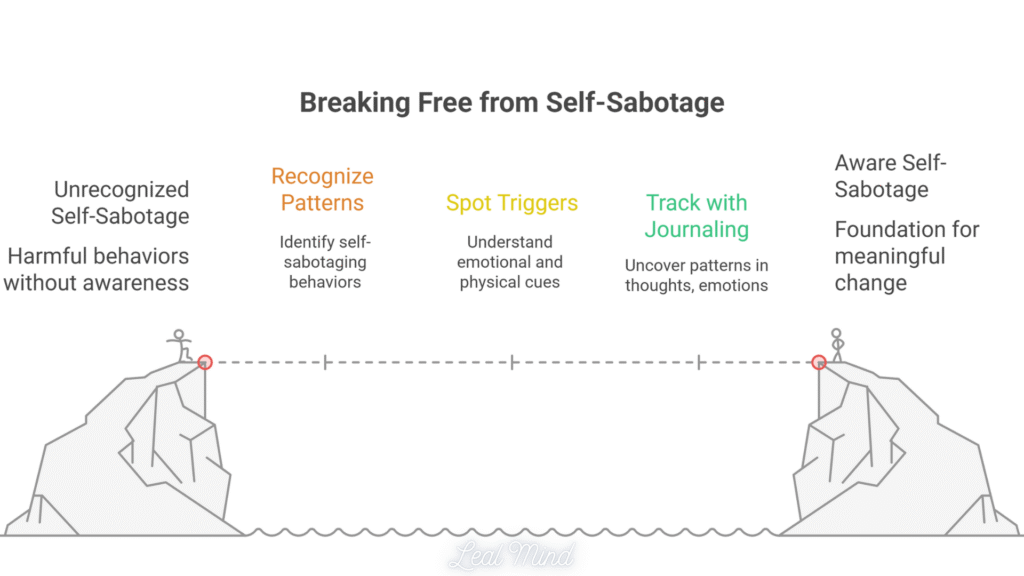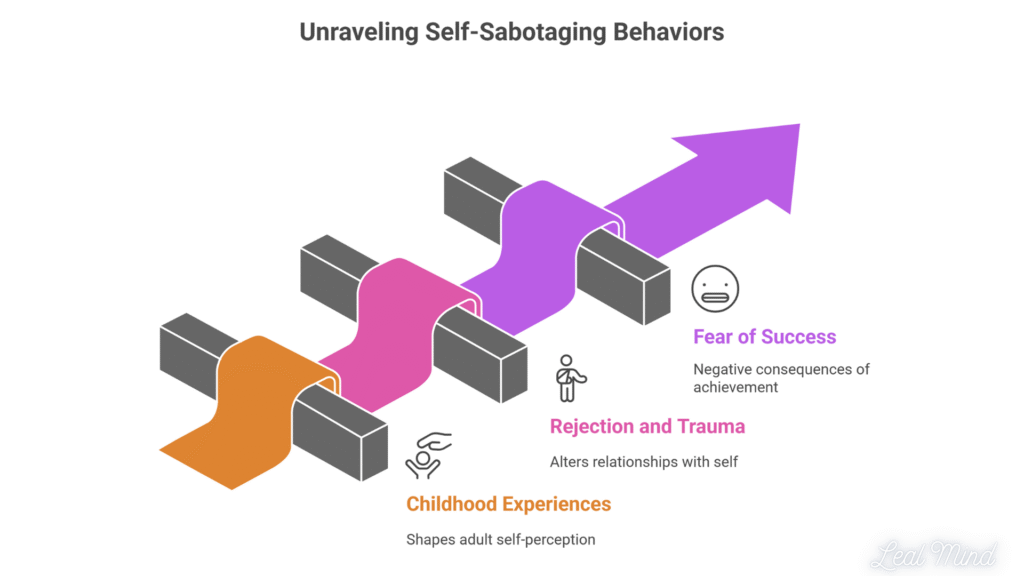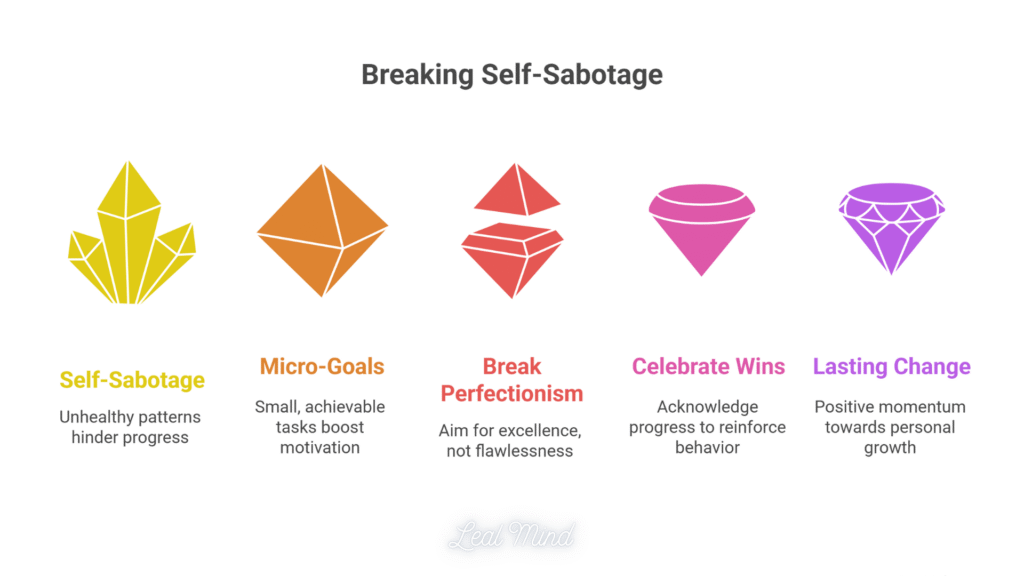Self-sabotage occurs when we hinder our own success, even when we genuinely want to achieve our goals. Have you ever noticed yourself procrastinating on important tasks, engaging in negative self-talk, or avoiding opportunities that could lead to growth? These behaviors are classic signs of self-sabotaging patterns.
Actually, self-sabotaging behavior refers to intentional actions or inactions that undermine our progress and prevent us from accomplishing what we want most. Common forms include procrastination, perfectionism, comfort eating, self-medication with drugs or alcohol, and even self-injury. Whether consciously choosing to eat unhealthy food despite health goals or unconsciously pushing away relationship opportunities, these patterns can affect every area of our lives.
Why do we do this to ourselves? Often, self-sabotaging stems from low self-esteem and unresolved issues from childhood or past relationships. These destructive messages are typically rooted in fear connected to old wounds. In fact, some psychologists view self-sabotage as a biological response that was once necessary for survival but now holds us back.
In this guide, I’ll walk you through five practical steps to identify, understand, and overcome your self-sabotaging tendencies. We’ll explore how to recognize harmful patterns, discover their origins, challenge your inner critic, take consistent action, and build lasting resilience.
Table of Contents

Step 1: Recognize your self-sabotaging patterns
Becoming aware of our self-sabotaging patterns is the first crucial step toward breaking free from them. Most of us engage in these behaviors without fully recognizing the harm they produce. Even when we make the connection, there’s often a strange tendency to repeat the behavior anyway.
What behaviors are holding you back?
Self-sabotage manifests in various ways, often so subtly that we miss them. Perfectionism is among the most misunderstood forms—a seemingly positive trait that actually robs us of happiness, connection, and opportunity. Perfectionists typically stay within their comfort zones and only act when they’re absolutely certain they’ll succeed.
Consider how perfectionism might be holding you back:
- Procrastination due to overwhelming expectations
- Inefficiency from focusing on minor details
- Avoiding public speaking or presentations due to anxiety
- Defensive responses to feedback
- Unwillingness to try new skills
Beyond perfectionism, other common self-sabotaging behaviors include negative self-talk, chronic people-pleasing, relationship sabotage, and neglecting self-care. Self-doubt can prevent you from challenging yourself or applying for dream jobs, while imposter syndrome might cause you to avoid situations where you’d receive praise.
How to spot emotional triggers
Self-sabotage triggers are the thoughts, feelings, or situations that precede self-defeating behaviors. They often lurk beneath the surface, categorized by your brain as old, familiar information that doesn’t require much attention.
To identify these triggers, pay attention to your emotional responses. For example, when you feel anxious about a work project, you might procrastinate. When feeling rejected, you might push away loved ones. These reactions are typically connected to deeper psychological fears and beliefs.
The most revealing moments are when success makes you uncomfortable. Notice when you’re about to achieve something important—do you suddenly feel anxious or find reasons to back away? This discomfort often signals a self-sabotage trigger.
Your body provides important clues too. Physical responses like tension, racing heart, or sudden fatigue when facing certain situations can indicate you’ve encountered a trigger. Furthermore, small changes in mood, routine, or thought patterns can be warning signs of impending self-sabotage.
Using journaling to track patterns
Journaling is a powerful tool for uncovering self-sabotage patterns. Start by setting an alarm twice daily (perhaps 9 a.m. and 6 p.m.) and when it rings, ask yourself, “What was I thinking just now?” Note these thoughts in a journal or phone app.
Next, whenever you experience a distressing emotion, write down:
- What you were thinking right before the emotion
- What triggered those thoughts
- How you responded
- Any potential harmful beliefs behind your response
This process helps you trace your steps and identify the “seemingly irrelevant decisions” (SIDs) that lead to self-sabotage. For instance, you don’t skip the gym at 3 p.m. when you’re tired; you skip it when you decide to stay up late and eat junk food for lunch, leaving you feeling lethargic.
Specific journal prompts can accelerate your awareness:
- How does not achieving my goals make me feel?
- What bad habits are hindering my success?
- What are the first signs of my self-sabotaging?
- Why do I make excuses for not succeeding?
Through consistent journaling, you’ll start noticing patterns in your thoughts, emotions, and behaviors. This awareness is your first defense against self-sabotage and creates the foundation for meaningful change.

Step 2: Understand where it comes from
Understanding the origins of self-sabotaging behaviors is crucial for breaking free from them. At the root of these patterns lie experiences that shaped how we see ourselves and interact with the world.
How childhood shapes adult behavior
Our early life experiences create powerful imprints that influence our adult behaviors. If we grew up in an abusive, neglectful, or otherwise unhealthy family environment, we likely developed certain roles and coping mechanisms for survival. These early adaptations often follow us into adulthood.
Children from dysfunctional families frequently carry implicit messages about not being worthy or fearing abandonment. Eventually, we may unconsciously recreate these familiar patterns in adult relationships, even though they cause pain. As adults, we sometimes turn to “comfortable misery” because it feels familiar.
Additionally, growing up in hostile environments can create unspoken expectations where we aren’t allowed to develop our own identity or question family dynamics. This often leads to fears around advocating for ourselves or stepping outside prescribed family roles.
Consider this: If your parents criticized your achievements or failed to acknowledge them, you might unconsciously undermine your success as an adult. One client from a wealthy family was gifted academically but received no encouragement from parents who ignored his skipping school and never supported college applications. Despite his intelligence, he sabotaged himself whenever success approached.
The impact of rejection and trauma
Trauma fundamentally alters how we relate to ourselves and others. The experience of rejection is particularly powerful, as our brains process social pain in the same regions where physical pain is processed. Neuroimaging scans confirm that rejection activates the anterior cingulate cortex – the same area that processes physical pain.
Self-sabotage often functions as a protective mechanism against anticipated rejection. By abandoning projects, relationships, or opportunities before they can “fail,” we attempt to shield ourselves from potential hurt. This avoidance becomes a trauma response – a self-preservation strategy developed earlier in life.
Consequently, many who experience trauma develop avoidance as their primary coping strategy. One psychologist describes this avoidance as similar to a Chinese finger trap – the harder you pull away, the tighter it grips. The more you avoid facing trauma, the more power it holds over you.
After experiencing early abuse or abandonment, our inner voice often transforms into our harshest critic, with messages like “Abandon before I get abandoned” or “Leave before I get left behind”. This creates a painful cycle where we repeatedly sabotage relationships to “protect” ourselves from anticipated abandonment.
Why fear of success is real
Surprisingly, many people unconsciously fear success more than failure. This phenomenon, though discussed less frequently than fear of failure, can be equally devastating to personal growth.
Fear of success typically revolves around several core concerns:
- Change and uncertainty that accompanies achievement
- Increased responsibility and higher standards
- Fear of backlash or negative social consequences
- Impostor syndrome and feelings of unworthiness
Our brains naturally resist change, even positive change, because we find comfort in routines. Furthermore, research shows that women in particular tend to associate success with more significant negative consequences, often fearing backlash for behaviors that don’t align with traditional gender roles.
Past experiences powerfully shape our relationship with success. If your achievements were once met with criticism, mockery, or even abuse, your brain learned to associate success with pain. For instance, one client whose father mocked his academic achievements (stemming from the father’s own insecurity about never graduating high school) learned to “keep his head down” and choose career paths that were “safe” rather than fulfilling.
Understanding these origins isn’t about assigning blame but recognizing that what appears as self-sabotage often began as self-protection. By identifying these root causes, you take the first crucial step toward changing these patterns.

Step 3: Challenge your inner critic
Our inner critic can be relentlessly harsh, constantly whispering that we’re not good enough, smart enough, or worthy of success. This negative internal dialog forms one of the most powerful mechanisms of self-sabotage, yet it’s also one we can effectively challenge.
Identifying negative self-talk
Negative self-talk operates through specific thought patterns that distort reality. Common forms include filtering (magnifying negatives while ignoring positives), catastrophizing (automatically expecting the worst), personalizing (blaming yourself for everything), and should statements (imposing rigid rules on yourself).
To recognize these patterns, try monitoring your thoughts for half a day. Write down negative self-talk as it occurs, noting when and where it happens. Pay special attention to thoughts that begin with “I always…” or “I never…” as these typically indicate limiting beliefs.
Keep a two-week journal logging your internal dialog hourly, alongside your location and activities. This practice often reveals surprising patterns—many people discover their self-talk is far harsher than anything they’d ever say to a friend.
Rewriting limiting beliefs
Once you’ve identified these thought patterns, it’s time to challenge them. Ask yourself: “Is this thought actually true? Am I assuming the worst? Is this based on facts or just feelings?”
A powerful technique involves gathering evidence against your negative beliefs. When you think “I never accomplish anything,” list specific achievements that contradict this statement. Additionally, question whether your limiting beliefs are truly serving you or merely protecting you from perceived risks.
For beliefs that feel deeply ingrained, try the “alternative belief” approach. Create hypotheses that counter your negative assumptions, then test them in real situations. Moreover, when negative thoughts arise, simply asking yourself “What if I’m wrong?” can diminish their power.
Building a new internal narrative
Creating a healthier internal dialog requires intentional practice. Replace absolute statements with more balanced perspectives—instead of “I’m a failure,” try “I made a mistake and I can learn from it”.
Remember that challenging negative self-talk isn’t about silencing your inner voice but redirecting it toward kindness. One effective approach involves naming your inner critic (like “Becky”) to create separation between yourself and these thoughts.
With repeated practice, your brain forms new neural pathways through neuroplasticity. Just as negative thought patterns became entrenched through repetition, positive ones can gradually become your default mode. Know how to love yourself and be confident.

Step 4: Take small, consistent actions
Taking action is the bridge between awareness and real change when stopping self-sabotage. Knowledge alone won’t transform your patterns—only consistent steps forward can do that.
Start with micro-goals
Micro-goals are small, manageable tasks that break down larger ambitions into bite-sized pieces. Research shows these tiny objectives directly activate your brain’s reward system, releasing dopamine that boosts motivation.
When facing self-sabotage, grand goals often trigger overwhelming feelings that lead to avoidance. Instead:
- Set achievable daily or weekly targets (like writing 400 words daily instead of an entire book)
- Break projects into 30-minute work blocks to maintain energy
- Create written action plans with realistic timeframes for each small step
This approach prevents your sabotaging mind from “putting on the brakes” when facing change. As one psychologist noted while working with a client named Jada, breaking annual goals into quarterly, monthly, and weekly objectives provided clear markers of progress.
Break the perfectionism loop
Perfectionism creates a destructive cycle that begins with the belief that your worth depends on flawless performance. This triggers procrastination, followed by overworking and eventually feelings of guilt, shame, and self-criticism.
To disrupt this loop:
Aim for excellence, not perfection. This shift allows you to make progress without the paralyzing pressure of flawlessness.
Additionally, when you find yourself overthinking minor details, remind yourself that perfectionism often wastes time on unimportant aspects. As noted by one therapist, “letting go of rigid expectations and prioritizing wellbeing” was essential for clients escaping this cycle.
Celebrate small wins
Acknowledging progress—regardless how small—solidifies neural pathways that reinforce positive behavior. This practice helps your brain recognize which actions led to achievement, making you more intentional with future steps.
Decide beforehand what small rewards you’ll enjoy after reaching milestones. Examples include a specialty coffee, a half-day off, or a new plant for your workspace. This creates anticipation and additional motivation.
The impact extends beyond momentary pleasure—celebrating small victories improves confidence in your abilities and proves you can handle challenges. On the whole, this practice creates an upward spiral of positivity and momentum toward lasting change.
Step 5: Build long-term resilience
Building resilience against self-sabotage requires ongoing effort. Much like maintaining physical fitness, psychological resilience needs consistent attention to flourish.
Practice self-compassion daily
Self-compassion isn’t about feeling good—it’s about treating yourself with kindness during difficult moments. Research shows this practice reduces depression, anxiety, and stress. Think of self-compassion as becoming your own best friend.
Try placing your hand on your heart when feeling overwhelmed—this simple gesture releases oxytocin, a calming hormone. Afterward, ask yourself, “What do I need right now to feel better?”
Learn to tolerate discomfort
Emotional discomfort is inevitable, yet many of us respond by avoiding it completely. Learning distress tolerance helps you face difficult feelings without making situations worse.
This skill allows you to withstand emotional discomfort until you can address its source. Subsequently, you’ll build greater emotional stability and improved mental wellbeing.
Use therapy and support systems
Professional support makes a tremendous difference. Cognitive-behavioral therapy (CBT) helps recognize negative thought patterns, whereas dialectical behavior therapy (DBT) teaches emotional regulation.
Beyond therapy, build a network of people who provide emotional and practical support. Such connections are associated with better health outcomes and increased longevity.
Stay committed to growth
Personal growth isn’t a destination but a lifelong journey. According to research, continued personal development is essential for wellbeing, supporting us through challenges and changes.
View setbacks as opportunities. Each time you overcome self-sabotage, you strengthen neural pathways that make future progress easier. Here are 10 mental health tips that work.
Conclusion
Breaking free from self-sabotage requires both awareness and deliberate action. Throughout this guide, we’ve explored how these destructive patterns develop and persist despite our conscious desire for success. Your journey toward overcoming self-sabotage begins with recognizing harmful behaviors, then understanding their origins in past experiences.
Most people find that challenging their inner critic creates significant momentum. This critical voice may have protected you once, but now prevents your growth and happiness. Small, consistent actions will gradually replace old patterns with healthier alternatives.
Research shows that people who practice self-compassion experience 43% fewer mental health issues than those who habitually criticize themselves. This fact alone makes developing kinder self-talk worth the effort.
Remember that setbacks will occur. These moments don’t define your journey—they simply provide valuable learning opportunities. Each time you notice self-sabotage and choose differently, you strengthen new neural pathways in your brain.
Your capacity for change is greater than you realize. The five-step process outlined here offers a roadmap, but the courage to follow it comes from within you. Self-sabotage may have limited your past, but it certainly doesn’t need to determine your future.
Start today with one small step—perhaps journaling about a recurring pattern or practicing self-compassion during a difficult moment. After all, the journey of overcoming self-sabotage begins not with dramatic transformation but with these seemingly small choices that ultimately lead to lasting change. Read more about self-sabotage.
FAQs
What are some common signs of self-sabotaging behavior?
Common signs include procrastination, perfectionism, negative self-talk, avoiding opportunities for growth, and engaging in harmful habits that hinder progress towards goals. These behaviors often stem from underlying fears or limiting beliefs.
How can I identify my self-sabotaging patterns?
Start by journaling your thoughts, emotions, and behaviors daily. Pay attention to situations where you feel uncomfortable with success or find yourself making excuses. Look for recurring themes or triggers that lead to self-defeating actions.
Can childhood experiences contribute to self-sabotage in adulthood?
Yes, childhood experiences significantly shape adult behavior. Early life trauma, criticism, or neglect can lead to the development of coping mechanisms that may manifest as self-sabotage later in life. Understanding these origins is crucial for breaking the cycle.
What role does the inner critic play in self-sabotage?
The inner critic often fuels self-sabotage through negative self-talk and limiting beliefs. It can undermine confidence and lead to avoidance of opportunities. Challenging and reframing these thoughts is essential for overcoming self-sabotaging tendencies.
How can I build resilience against self-sabotage?
Building resilience involves practicing self-compassion, learning to tolerate discomfort, seeking support through therapy or support systems, and staying committed to personal growth. Consistently taking small actions and celebrating progress, no matter how minor, can also strengthen resilience over time.









